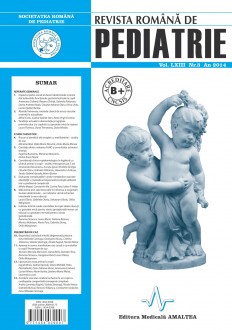SELECT ISSUE

Indexed

| |

|
|
|
| |
|
|
|

|
|
|
|
|
|
|
HIGHLIGHTS
National Awards “Science and Research”
NEW! RJP has announced the annually National Award for "Science and Research" for the best scientific articles published throughout the year in the official journal.
Read the Recommendations for the Conduct, Reporting, Editing, and Publication of Scholarly work in Medical Journals.
The published medical research literature is a global public good. Medical journal editors have a social responsibility to promote global health by publishing, whenever possible, research that furthers health worldwide.
RISKS AND BENEFITS OF METHYLXANTHINES THERAPY – CASE STUDY
Mariana Boia, Delia Maria Nicoara and Aniko Maria Manea
ABSTRACT
Introduction. Apnea of prematurity (AOP), a developmental disorder of respiratory control present in approximately 80% of extremely low birth weight (ELBW) infants, that, if prolonged, may cause hypoxemia and low cardiac output, with subsequent neurodevelopmental compromise.
Material and method. Retrospective study in a regional referral level III neonatal intensive care unit, sought to evaluate our experience with methylxanthines treatment for recurrent apneic spells in 84 preterm infants with gestational age of < 32 weeks and birth weight of < 1,500 g.
Results. The median maintenance dose was 5 mg/kg/d for caffeine citrate, and 3 mg/kg/d for theophylline. There was no difference in mean apnea rate between caffeine and theophylline groups after one to week of treatment, with similar need for continuous positive airway pressure and supplementary oxygen requirements in both groups. Adverse effects, such as tachycardia, feeding intolerance and failure to gain weight leading to change in dosage, were lower in the caffeine group.
Conclusions. Lower postmenstrual age (less than 28,2 weeks) were associated with increased need for methylxanthines weight adjustments and mini-loads, as these infants required longer courses of therapy. While both methylxanthines are as effective in treating apneic preterms, caffeine citrate was the preferred drug given its wider therapeutic margin, and fewer adverse effects.
Keywords: apnea of prematurity, methylxanthines, adverse effects
